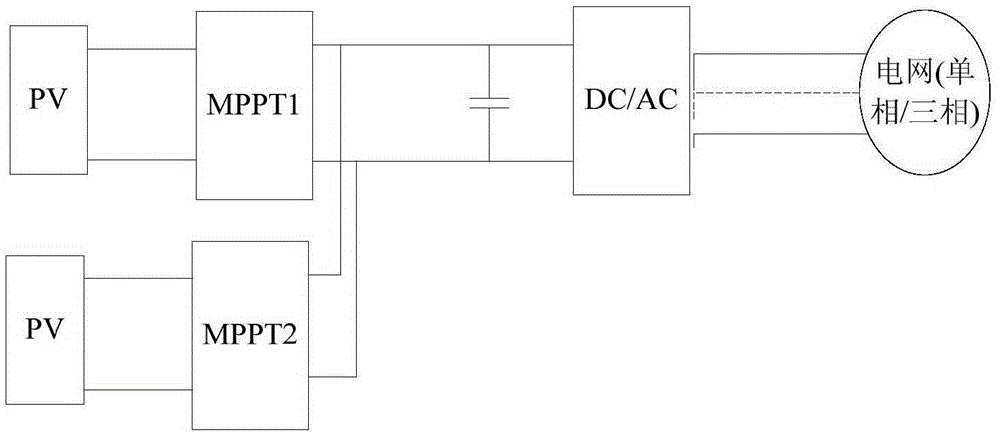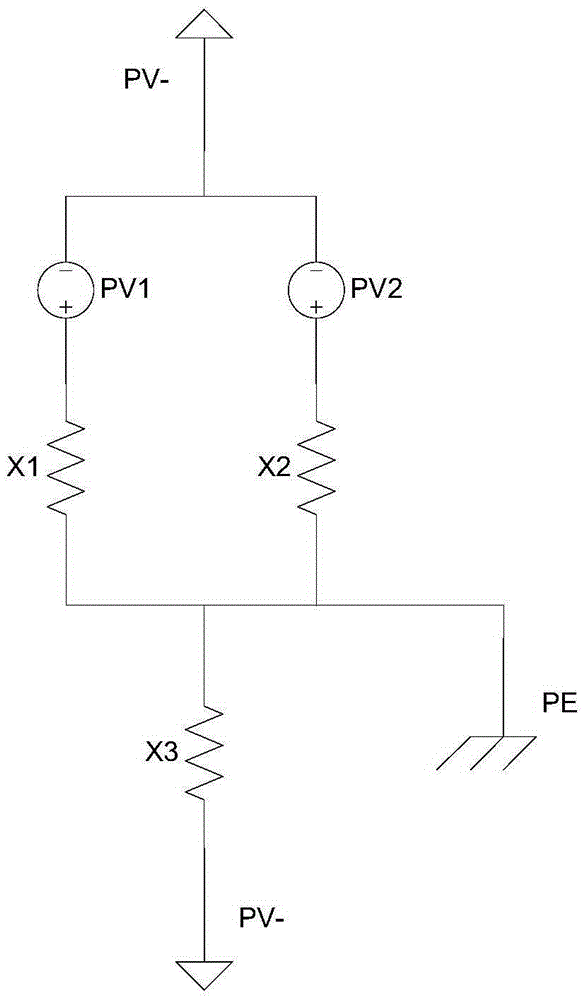Multipath MPPT input photovoltaic inverter insulation impedance detection device and method
A photovoltaic inverter and insulation resistance technology, which is used in photovoltaic system monitoring, impedance measurement, photovoltaic power generation, etc., can solve problems such as failure of the solution, inability to accurately detect the insulation resistance value of the system, and achieve high precision.
- Summary
- Abstract
- Description
- Claims
- Application Information
AI Technical Summary
Problems solved by technology
Method used
Image
Examples
Embodiment 1
[0045] Embodiment 1: The sub-circuit connected between the positive pole PVn+ of n solar panels in the photovoltaic system and the ground includes n branches that can be turned on and off independently, and each branch is connected to a solar cell in the photovoltaic system. Between the positive pole PVn+ of the board and the ground, each branch includes a first switch and a first resistor connected in series. The sub-circuit connected between the negative pole PV- and ground includes a second switch and a second resistor connected in series.
[0046] as attached image 3 As shown, in this embodiment, taking a dual-channel MPPT input photovoltaic inverter as an example, it is connected to the positive poles PV1+ and PV2+ of the two solar panels in the photovoltaic system, and the negative poles of the two solar panels are connected to PV -. The insulation resistance of the positive pole PV1+ to the ground is X1, the insulation resistance of the positive pole PV2+ to the grou...
Embodiment 2
[0077] Embodiment two: as attached Figure 5 As shown, compared with the first embodiment, this embodiment is based on four MPPT input photovoltaic inverters. It is connected to the positive poles PV1+, PV2+, PV3+, and PV4+ of the four solar panels in the photovoltaic system, and the negative poles of the four solar panels are connected to PV-. The insulation resistance of positive PV1+ to ground is X1, the insulation resistance of positive PV2+ to ground is X2, the insulation resistance of positive PV3+ to ground is X3, the insulation resistance of positive PV4+ to ground is X4, and the insulation resistance of negative PV- to ground is X5 . The sub-circuit connected between the positive poles PV1+, PV2+, PV3+, PV4+ of the four solar panels in the photovoltaic system and the ground includes four branches that can be turned on and off independently, and the positive poles PV1+, PV2+, PV3+, and PV4+ are respectively connected to one Each branch includes a first switch and a f...
Embodiment 3
[0078] Embodiment 3: The sub-circuit connected between the positive pole PVn+ of n solar panels in the photovoltaic system and the ground includes n branches that can be turned on and off independently, and each branch is correspondingly connected to a solar cell in the photovoltaic system Between the positive pole PVn+ of the board and the ground, each branch includes several first resistors connected in series and a first switch connected in parallel to both ends of one first resistor. The sub-circuit connected between the negative pole PV- and the ground includes several second resistors connected in series and a second switch connected in parallel to both ends of one second resistor.
[0079] as attached Figure 6As shown, the dual-channel MPPT input photovoltaic inverter is still taken as an example. It is connected to the positive poles PV1+ and PV2+ of the two solar panels in the photovoltaic system, and the negative poles of the two solar panels are connected to PV-. ...
PUM
 Login to View More
Login to View More Abstract
Description
Claims
Application Information
 Login to View More
Login to View More - R&D
- Intellectual Property
- Life Sciences
- Materials
- Tech Scout
- Unparalleled Data Quality
- Higher Quality Content
- 60% Fewer Hallucinations
Browse by: Latest US Patents, China's latest patents, Technical Efficacy Thesaurus, Application Domain, Technology Topic, Popular Technical Reports.
© 2025 PatSnap. All rights reserved.Legal|Privacy policy|Modern Slavery Act Transparency Statement|Sitemap|About US| Contact US: help@patsnap.com



